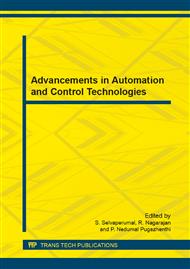p.747
p.757
p.767
p.777
p.785
p.791
p.797
p.803
p.808
Study of Gas Sensors for the Detection of Volatile Organic Compounds in Breath
Abstract:
Volatile organic compounds (VOCs) are organic chemicals that encompass a high vapour pressure .The VOCs are numerous and varied. In breath the concentration of VOCs ranges from parts per million to parts per trillion. The discovery of VOCs in breath is used as a diagnostic tool for many diseases, disorders and metabolic studies. So far these gases have been identified using gas chromatography (GC) which is time consuming and expensive technique. With the introduction of sensors as frontend to detect vapour signals, the work can be processed easier. This article proposes a system for breath analysis using tin oxide semiconductor gas sensors, in which the conductivity changes depending on the concentration of the vapour. A prototype model was developed to detect the presence of acetone in the breath, which is a biomarker for diabetes mellitus. This study has been helpful in designing an electronic nose for detecting other vapours like benzene, ammonia and Nitric oxide which are the biomarkers for lung cancer, renal disorder and asthmatic inflammation.
Info:
Periodical:
Pages:
785-790
Citation:
Online since:
June 2014
Authors:
Keywords:
Price:
Сopyright:
© 2014 Trans Tech Publications Ltd. All Rights Reserved
Share:
Citation:


